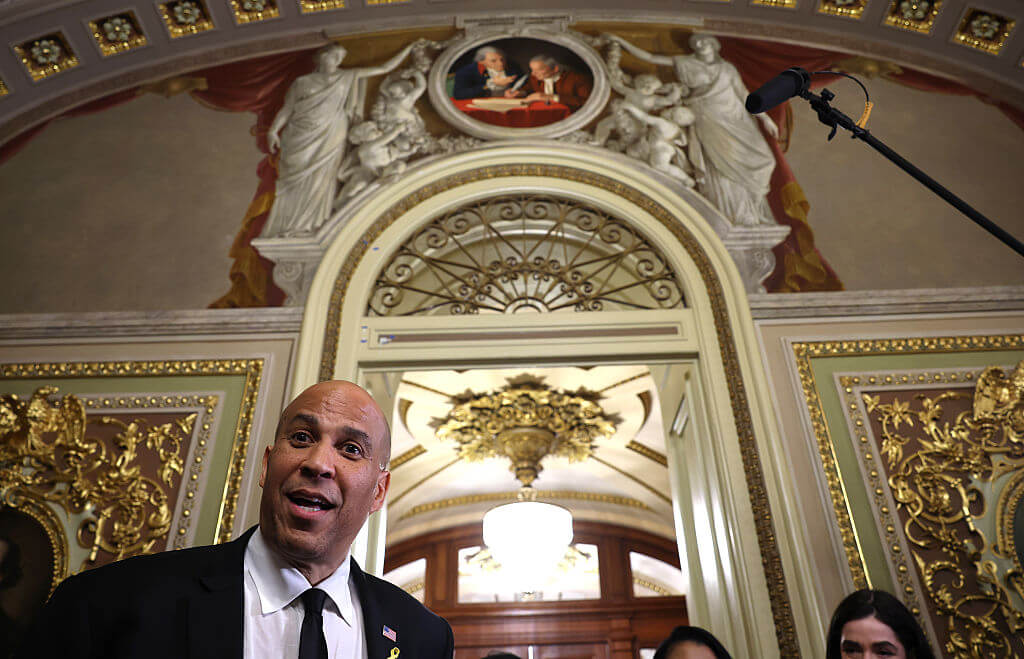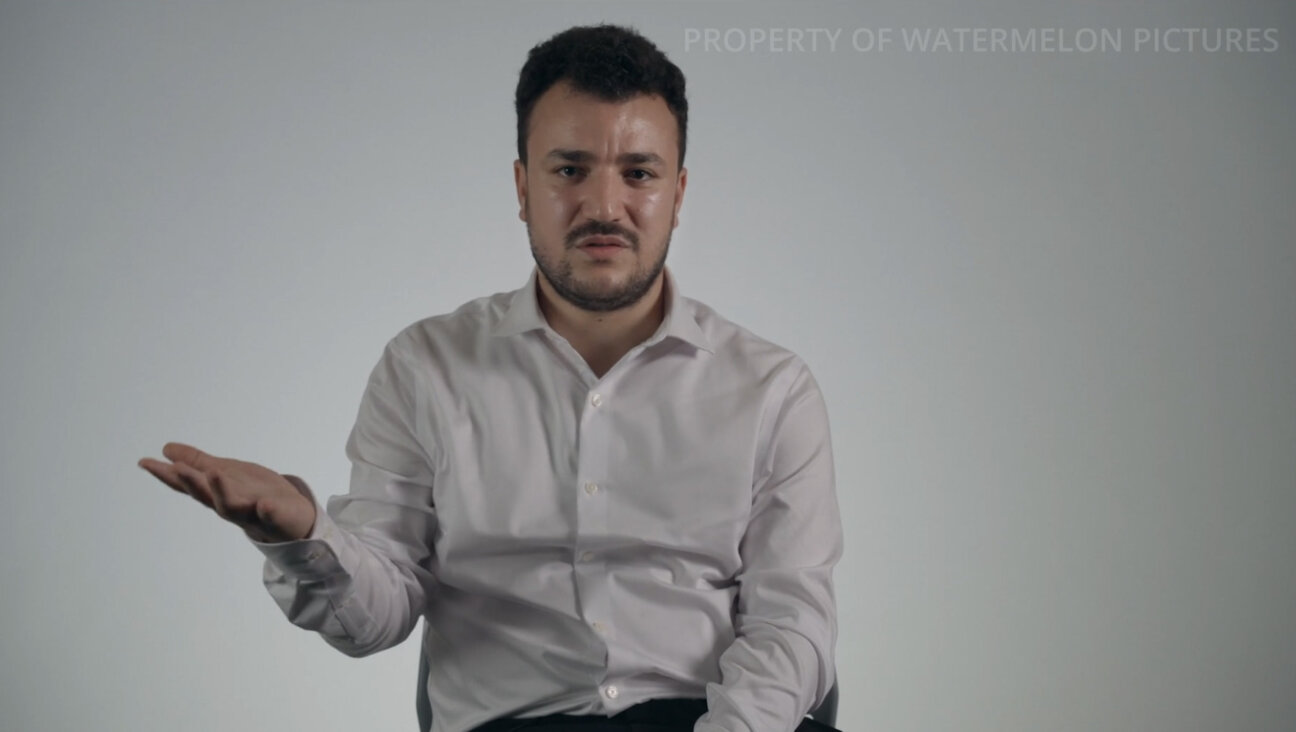Solar Panels To Bloom in the Negev as Israel Embarks on a Green Revolution

Zionism?s Eco-Frontier: Yosef Abramowitz, president of Arava Power, stands next to some of the panels that will be set up in the southern Negev at the company?s pioneering solar site. Image by GETTY IMAGES
Four years ago, on the morning after Boston businessman Yosef Abramowitz arrived in Israel’s Negev desert for some rest and relaxation, he took a walk that changed the face of Israeli energy.
“It was 5 a.m. I came out with my skin burning from the sun, and I said, ‘Wow, this place must be running on solar power,’” Abramowitz recalled. Yet he soon discovered that there wasn’t a single major solar project in Israel, despite the breadth of the eternally sunny Negev.
On November 18, a company that Abramowitz set up shortly after that walk, Arava Power — named after the Arava Valley near Eilat, where he was staying — signed the first purchase agreement for renewable energy in Israeli history. In a deal worth $68 million, the electrical power monopoly Israel Electric Corp. committed itself for 20 years to buy power from fields the company establishes. On November 21, the Ministry of National Infrastructures approved the deal.
The 27-employee Arava Power has already signed deals with 35 kibbutzim and moshavim, as well as five Bedouin families, to erect solar panels on their lands. Almost all are in the Negev, where the climate is considered perfect for solar fields.
When Abramowitz, now the company’s president, first approached IEC and the government, officials did not even have procedures for dealing with major bids for green electricity. Since assessing and adopting his bid, officials have become keen for more of the same. By January 2009, the state had set itself a target of sourcing 10% of electricity from renewable supplies by 2020, and on November 28, it announced a $550 million plan to reduce greenhouse gases, including a “complementary plan on green energy.”
IEC, responding to questions from the Forward regarding the Arava Power deal, said that it “anticipates hundreds of similar contracts.” Yiftah Ron-Tal, chairman of IEC’s board, said: “IEC welcomes the introduction of independent power producers into the special green energy system and leaves no stone unturned to promote these producers and to connect them to the grid promptly.”
Abramowitz believes that solar energy for Israel constitutes an updating of the Zionist dream. “Because of the shortage of water in Israel, you can’t really make the desert green, but you can make green energy in the desert,” he told the Forward, adding that he hopes this energy will make the Jewish state a “renewable light unto the nations.”
The past leader of the campaign for Soviet Jewry and co-creator of the popular My Jewish Learning website, Abramowitz has been featured three times for education and activism in this newspaper’s Forward 50 list of American Jews who have had a big impact. He’s one of many American players involved in Israel’s adoption of renewable energy; in fact, American investment paid for the establishment of Arava Power.
The idea for the company was hatched and developed on Kibbutz Ketura, established in 1973 by members of the American Jewish youth movement called Young Judea. American expatriates make up the majority of the 150 adult members of the kibbutz. In the 1980s, Abramowitz had participated in Young Judea’s yearlong post-high-school program, and when he took time out in 2006 with the intention of writing a book on Jewish thought, he headed back to Ketura. The book didn’t happen- but Abramowitz remained in Israel (though now in Jerusalem), determined to see through the start of power production.
Initially, Ketura owned half the company and the American investors, headed by Abramowitz, owned the other half. Now, electronics giant Siemens owns 36% — which it purchased last year for $15 million — Ketura owns 15%, the charity Keren Kayemet LeYisrael-Jewish National Fund bought in with a 4% share in January, and American investors own the remainder.
And despite the involvement of high-level players, Israel’s first solar field will still be on Kibbutz Ketura. A week after the government ratified Arava Power’s purchase agreement, Roy Kagan, Ketura’s business manager, was excited about what it will mean for his community; he has “high hopes” that this will bring prosperity.
While older kibbutzim began diversifying beyond agriculture as early as the 1930s, Ketura is much younger, and the belief that pioneering means agriculture is one that lasted longer there, he said. Founders “thought they could support themselves from within the fence of the kibbutz, which I think was a little naive,” Kagan said. He recounted that in the early 1970s, Ketura members were offered work manning a pumping station for the Eilat-Ashkelon Pipeline Co. Ltd. but refused on principle. Nonagricultural projects did not begin in earnest until 1990.
The desert sand on the first solar field has already been flattened. The 20-acre site is fenced off, and high-tech security devices have been installed. Just outside the fence, 900 wooden crates hold 18,000 solar panels, recently imported from China. Siemens engineers will assemble these panels, and by the end of June 2011 they will be pumping out 4.9 megawatts of electricity per hour during sunlight.
Within three years, a second, larger site should be producing 40 megawatts of power per hour during sunlight. This means that between its two sites, Ketura alone will be producing a third of all energy needed for its neighboring kibbutzim and the large resort of Eilat.
Factoring all its sites and projected additions into its portfolio, the company expects to singlehandedly meet the government target to make 10% of Israel’s energy sustainable by 2020 — and hopes that other companies will help the renewable sector to beat the target and provide 20% of all Israel’s electricity. The company, however, is not commenting on anticipated profits.
Members from Kibbutz Ketura’s early days welcome the solar project, but they are divided on whether it represents a departure from their original vision. California native Elaine Soloway, who joined Ketura in 1974 at age 21, said that an agricultural kibbutz “is what we aimed to be when we were young, but we found it didn’t work out economically, as the price of fruit and vegetables was low while the cost of labor and water was high. The only way we could pretend to be profitable was by not counting our own hours.”
Commenting that privatization has been most common on kibbutzim facing financial difficulties, Ketura-nik Jonathan Chester, 38, said, “Solar will give us the financial stability that will let us continue to be like this — to be dreamers.”
Contact Nathan Jeffay at [email protected]
The Forward is free to read, but it isn’t free to produce

I hope you appreciated this article. Before you go, I’d like to ask you to please support the Forward.
At a time when other newsrooms are closing or cutting back, the Forward has removed its paywall and invested additional resources to report on the ground from Israel and around the U.S. on the impact of the war, rising antisemitism and polarized discourse.
Readers like you make it all possible. We’ve started our Passover Fundraising Drive, and we need 1,800 readers like you to step up to support the Forward by April 21. Members of the Forward board are even matching the first 1,000 gifts, up to $70,000.
This is a great time to support independent Jewish journalism, because every dollar goes twice as far.
— Rachel Fishman Feddersen, Publisher and CEO
2X match on all Passover gifts!
Most Popular
- 1

Fast Forward Cory Booker proclaims, ‘Hineni’ — I am here — 19 hours into anti-Trump Senate speech
- 2

Opinion Trump’s Israel tariffs are a BDS dream come true — can Netanyahu make him rethink them?
- 3

Fast Forward Cory Booker’s rabbi has notes on Booker’s 25-hour speech
- 4

News Rabbis revolt over LGBTQ+ club, exposing fight over queer acceptance at Yeshiva University
In Case You Missed It
-

Fast Forward Trump says US has begun direct talks with Iran over its nuclear program
-

Fast Forward In new letter, Mahmoud Khalil downplays campus antisemitism and accuses some students of ‘participating in the genocide’
-

Fast Forward Play about Roald Dahl’s antisemitism wins 3 Olivier Awards
-

Opinion A legacy of defiance: Why I’m holding my Seder in one of the oldest Black churches in the country
-
Shop the Forward Store
100% of profits support our journalism
Republish This Story
Please read before republishing
We’re happy to make this story available to republish for free, unless it originated with JTA, Haaretz or another publication (as indicated on the article) and as long as you follow our guidelines.
You must comply with the following:
- Credit the Forward
- Retain our pixel
- Preserve our canonical link in Google search
- Add a noindex tag in Google search
See our full guidelines for more information, and this guide for detail about canonical URLs.
To republish, copy the HTML by clicking on the yellow button to the right; it includes our tracking pixel, all paragraph styles and hyperlinks, the author byline and credit to the Forward. It does not include images; to avoid copyright violations, you must add them manually, following our guidelines. Please email us at [email protected], subject line “republish,” with any questions or to let us know what stories you’re picking up.














